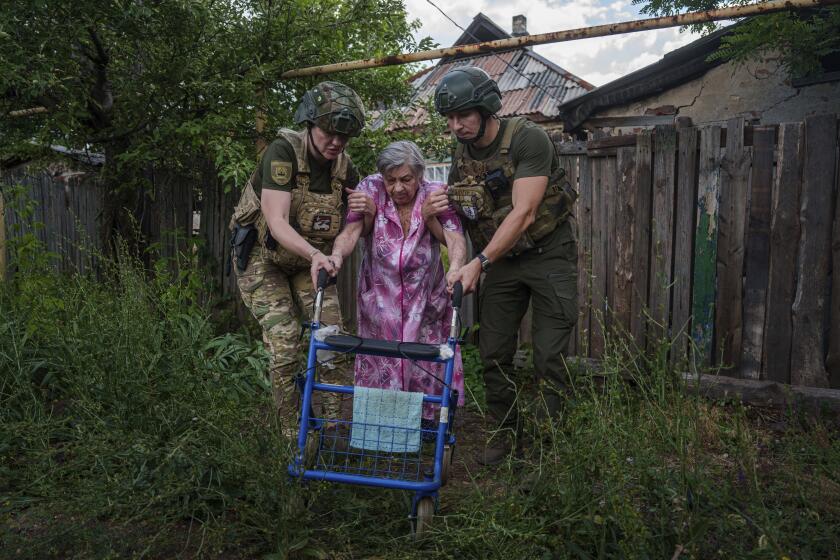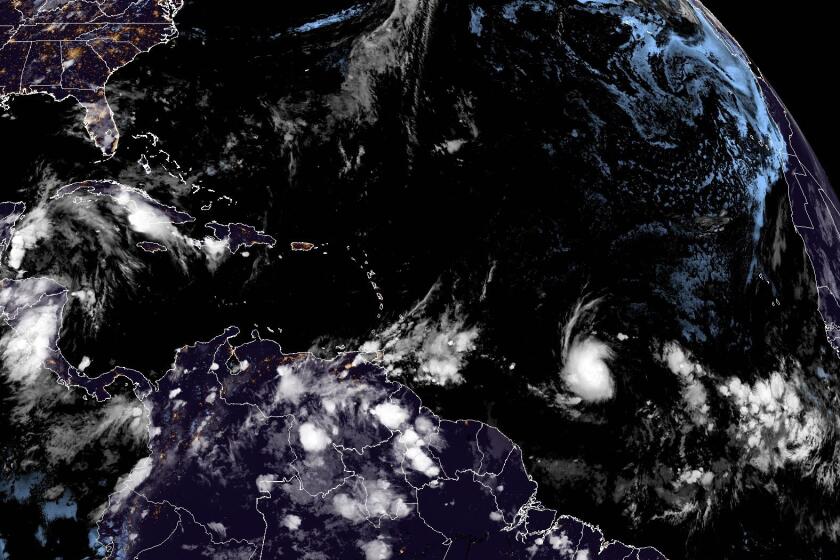Chumash Sites Exposed to New Risks
Deep in the Sespe Wilderness north of Ojai, archeologist Steve Galbraith knelt on the scorched earth and wiped clean a cutting stone he’d plucked from the bush.
As he examined the Chumash Indian artifact, several questions came to mind. Who fashioned this prehistoric cooking tool? Was it 2,000 or 3,000 years old? What other treasures lay hidden in the clay soil?
And perhaps most important: How could he keep such valuables out of the hands of thieves who prey on Native American archeological sites?
With predictions that Southern California’s wildfire season could be among its worst ever, archeologists, park rangers and law enforcement officers are bracing for the expected return of looters who see opportunity and riches amid the ash.
“They are stealing from everyone,” Galbraith said, as he stepped gingerly through waist-high chaparral searching for tools, arrowheads, bowls and other Chumash remnants that may have surfaced in the wake of the Wolf fire in Los Padres National Forest.
“It’s part of our American heritage and part of our American culture,” he said of the ancient burial grounds. “It’s who we are.”
Galbraith and fellow archeologist Janine McFarland will spend a few weeks combing through the forest to assess damage to the sites, rock paintings and artifacts that may have been in the path of the 23,000-acre wildfire, which was contained June 14. Across Southern California, nearly 74,000 acres of wilderness have burned this year, exposing canyons and hillsides that had been covered by trees and thick brush, some for hundreds of years. More than 22,000 federally protected sites within the region contain the remnants of Native American life going back 10,000 years or more, officials said.
Park rangers and law enforcement authorities are stepping up patrols and education programs directed at hikers and campers to warn them about the fines and penalties associated with pilfering. Theft of Native American relics and desecration of federally protected sites are both punishable by a maximum fine of $250,000 and up to two years in federal prison.
“Looters do take a forest fire as an opportunity to discover archeological areas because the brush that would hide them is gone,” said Joseph Johns, an assistant U.S. attorney in Los Angeles who specializes in investigating environmental crimes. “We want people to know we’re going to be out looking for them.”
Johns said a task force of federal, state and local law enforcement officials recently began holding strategy meetings to devise new ways to catch looters. One plan calls for installing sensors at sites that would alert law enforcement officers if someone enters the area, he said.
Rare arrowheads, skulls, bones, baskets and other relics can bring tens of thousands of dollars from collectors, officials said. Some looters carve out rock art. Others use special equipment for probing beneath the earth’s surface for buried pots and utensils.
“It’s an issue that we take seriously because they are not just stealing from the [national forest], they are destroying a page out of a history book that can never be replaced,” said Todd Swain, a special agent for the National Park Service whose patrol area includes Channel Islands National Park, Mojave Desert, Arizona and Nevada.
“Some are very sophisticated and they know where to go to look for stuff and they know its value. These people aren’t Osama bin Laden, but these things need to be protected.”
Marcus Lopez, a member of the elders council of the Barbareno Chumash Council in Santa Barbara, said greed and disrespect drive most thieves. He said looting has become a major problem in California and the Southwest.
“There are no words to articulate the grief and anger,” Lopez said. “People don’t understand to leave [artifacts] alone. It’s not your property. If I find something in your house, I leave it.”
A Santa Barbara woman was convicted last year of paying a contractor to dig up an ancient Chumash village along the Santa Ynez River in Los Padres National Forest so she could move her cabin there. She is scheduled to be sentenced July 8.
Ojai resident Jaret Owens was detained in a federal grave-robbing investigation on Santa Cruz Island in 1997, although he was never charged. Federal agents raided his home and confiscated Chumash artifacts that he and his father had collected.
The items were returned to Owens, 52, who said that he never sold artifacts for profit and that the pieces were collected before the Archeological Resources Protection Act was passed in 1979.
“Protect yourself from the claws of the park service and don’t pick anything up,” he said.Meanwhile, archeologists continue to scour the charred wilderness in Ventura County, looking to recover artifacts and checking for damage. Ancient rock art--which includes depictions of day-to-day life among the Chumash--sustained soot and smoke damage, said Joan Brandoff-Kerr, chief archeologist for Los Padres National Forest.
Brandoff-Kerr said surveys completed in the next few weeks should provide information on artifact damage, previously unknown rock drawings and other relics uncovered by the recent fire. The survey also will determine the sites most vulnerable to looters, she said.
“There is some pretty spectacular rock art out there,” she said. “I’m very concerned because we know the people that do this and they know what they are doing. The people that would buy this stuff in the black market are just as bad as the people who take it. It’s a dirty business.”
More to Read
Start your day right
Sign up for Essential California for news, features and recommendations from the L.A. Times and beyond in your inbox six days a week.
You may occasionally receive promotional content from the Los Angeles Times.






